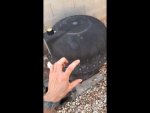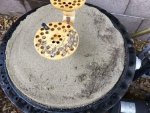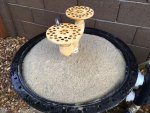I was planning to replace my sand this weekend when I decided to check here and found the thread on deep cleaning sand filter media. I have a Sta-Rite HRPB30 which is a 30-inch diameter filter with 400 lbs of sand. The last time I changed the sand in the filter was 12 years ago and the sand was 12 years old at the time. It was the original sand from the pool builder and I am the original owner of the pool. I knew the stuff about the sand "wearing out" was BS, however, everybody said I should've changed it already. When I changed the sand, what I found made me think changing it was a good idea. Basically, the outer layer of sand that touched the filter housing was a clay-like mud. It was nearly 3 inches thick at the top and only 1-inch thick nearer to the bottom. The rest of the sand looked normal and clean.
The same amount of time has passed, so I'm expecting the same layer of mud around the outside when I open it up again this weekend. However, after reading about deep cleaning, here's what I'm thinking of doing:
Scoop out all of the "clean" sand in the middle and save it.
Scoop out all of the "mud" around the edge and throw it away.
Deep-clean the sand I saved and put it back into the filter.
Add new sand to bring the media level up to where it's suppose to be.
Is this a reasonable plan? Based on what I remember, deep-cleaning the mud wouldn't be practical.
So, now I'm also wondering if I'm maintaining my filter correctly. My minimum filter pressure is 12psi right after backwashing. I backwash for 2-3 minutes when the pressure reaches 15-17psi. I also do what I thought was a deep cleaning by backwashing for 30 minutes once every 2 years. My backwash valve has only two positions; there's no rinse or bypass. I am I doing something wrong? Is the mud buildup a deficiency in my equipment? Would deep cleaning the sand every 4 or 5 years prevent the mud buildup?
Here's a photo of that outer layer of mud. I scraped down a couple inches so you can see the defining light/dark line between the normal sand and the muddy sand.
https://photos.app.goo.gl/TEXvuiNjJwmhNpNR2
The same amount of time has passed, so I'm expecting the same layer of mud around the outside when I open it up again this weekend. However, after reading about deep cleaning, here's what I'm thinking of doing:
Scoop out all of the "clean" sand in the middle and save it.
Scoop out all of the "mud" around the edge and throw it away.
Deep-clean the sand I saved and put it back into the filter.
Add new sand to bring the media level up to where it's suppose to be.
Is this a reasonable plan? Based on what I remember, deep-cleaning the mud wouldn't be practical.
So, now I'm also wondering if I'm maintaining my filter correctly. My minimum filter pressure is 12psi right after backwashing. I backwash for 2-3 minutes when the pressure reaches 15-17psi. I also do what I thought was a deep cleaning by backwashing for 30 minutes once every 2 years. My backwash valve has only two positions; there's no rinse or bypass. I am I doing something wrong? Is the mud buildup a deficiency in my equipment? Would deep cleaning the sand every 4 or 5 years prevent the mud buildup?
Here's a photo of that outer layer of mud. I scraped down a couple inches so you can see the defining light/dark line between the normal sand and the muddy sand.
https://photos.app.goo.gl/TEXvuiNjJwmhNpNR2
Last edited:




